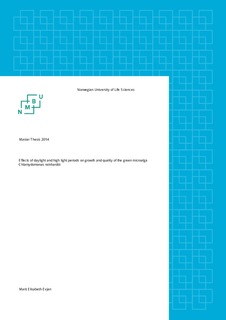| dc.description.abstract | The effect of high light intensities in form of daylight and simulated daylight conditions on the growth and quality of the green microalga Chlamydomonas reinhardtii was investigated. In the daylight experiments, cultures of C. reinhardtii were grown in a greenhouse with natural light conditions only, with a control of natural daylight plus a background light of 200 µmol m-2 s-1. The cultures were analysed for dry weight and starch content. In addition, different initial cell densities were used in the two treatments (10 000 cells mL-1 and 50 000 cells mL-1) to evaluate the effect on growth. The results showed that growth increased proportionally with natural light intensity during the days. During nights, growth (dry weight) slowed down or decreased. Starch accumulated during days, and decreased during nights. In the control treatments with continuous light in addition to daylight, dry weight and starch increased evenly throughout the experiment, before the growth stagnated and decreased 5-6 days into the experiment. The effect of the initial cell densities was not significant between the treatments. In the simulated light experiments, cultures were treated with 6 hours light periods of 500 and 1000 µmol m-2 s-1, both with continuous backlight of 200 µmol m-2 s-1, in addition to a control of continuous 200 µmol m-2 s-1. The cultures were analysed for dry weight, starch, chlorophyll and photoinhibition. Results showed that the cultures in high light treatments suffered dynamic photoinhibition. Cells in the medium light treatment were also photoinhibited, but on a lower level. However, dry weight and starch did not differ significantly between the three treatments. Chlorophyll decreased severely during the light periods. As dry weight of all experiments was lower than expected, the effects of air bubbling (CO2) velocity and content of calcium, magnesium or tap water in the growth medium were also tested. We concluded that a higher air bubbling velocity had a positive effect on algal growth, and that the High Salt Sueoka-medium should be enriched in calcium, magnesium, and sulphur. | nb_NO |
